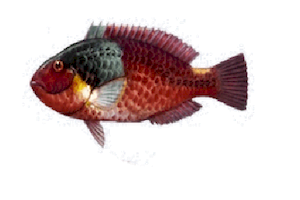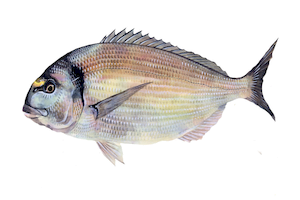
Synonyms
Opsodentex macrophthalmus Fowler, 1925: 4.
Scientific Name with Original Description
Sparus macrophthalmus Bloch, 1791. Nat. Ausl. Fische. 5: 93, pl. 272, (no locality).1791. Type: ZMB 1114.
Diagnostic Features
Body oval and compressed. Head profile regularly inclined from nape; eye very large, its diameter greater than snout length; suborbital space narrow; posterior nostril rounded. Cheeks scaly; scales also on preopercle, except at its posterior margin. Mouth low and oblique.
Several rows of canine-like teeth, outer row the strongest, with 4 well developed anterior teeth (in upper jaw, visible when mouth is closed) and 10 small anterior teeth (clearly smaller than the upper canines) in lower jaw.
Gillrakers in first arch 17 to 20 lower and 9 to 12 upper. Dorsal fin with 11 or 12 spines and 10 or 11 soft rays, the spines increasing in length from the first to the fourth or fifth and subequal thereafter. Anal fin with 3 spines and 8 or 9 soft rays. Scales along lateral line 49 to 55.
Colour of body and fins reddish, lateral line more bright red; spinous portion of dorsal fin whitish at base. Anal fin edged with white; inferior margin of lower caudal fin lobe white. The coloration becomes more intense during the spawning season.
Geographical Distribution
Mediterranean, very rare in the north-western basin, common in the south-western and abundant in the eastern basin; absent in Black Sea. Atlantic from Portugal (rare) to Cape Verde including the Canary Islands, and from Congo to Namibia; abundant along Morocco coast.
related Launch the Aquatic Species Distribution map viewer
Habitat and Biology
Benthopelagic (demersal behaviour)On the shelf and slope, inhabiting rocky or sandy bottoms from 30 to 500 m (Atlantic), less in Mediterranean (100-200 m Aegean Sea, 250 m Lebanon coast). Large specimens further from the shore than the young.
Seasonal migrations to and off the coast according to local hydrological variations and biological cycle.
Reproduction in March-April (Atlantic), April-May (southern Mediterranean); maturity at 2 years (about 24 cm); gonochoric; sex ratio: 70% females (Atlantic).
Carnivorous (fish and crustaceans), young planktonophagus.
Size
Maximum 65 cm; common to 24 cm
Interest to Fisheries
Caught with bottom trawls, bottom longlines and on hooks and lines. Catch statistics reported for this species totalled 29 000 t in 1977; most of the catch (about 23 000 t) was taken by the URRS in the southern.
Flesh highly esteemed. Marketed fresh or frozen; also used for fishmeal and oil.

























































































































































































































